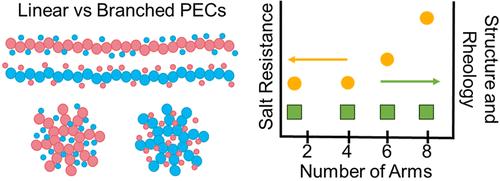当前位置:
X-MOL 学术
›
ACS Macro Lett.
›
论文详情
Our official English website, www.x-mol.net, welcomes your feedback! (Note: you will need to create a separate account there.)
Impact of a Lightly Branched Star Polyelectrolyte Architecture on Polyelectrolyte Complexes
ACS Macro Letters ( IF 5.1 ) Pub Date : 2024-05-23 , DOI: 10.1021/acsmacrolett.4c00167 Kaden C. Stevens 1 , Matthew V. Tirrell 1
ACS Macro Letters ( IF 5.1 ) Pub Date : 2024-05-23 , DOI: 10.1021/acsmacrolett.4c00167 Kaden C. Stevens 1 , Matthew V. Tirrell 1
Affiliation

|
The effect of charge density in blocky and statistical linear polyelectrolytes on polyelectrolyte complex (PEC) properties has been studied with the finding that increased charge density in a polyelectrolyte tends to increase the salt resistance and modulus of a PEC across various polyelectrolyte pairs. Here, we demonstrate the ability to orthogonally alter PEC salt resistance while maintaining rheological properties and internal structure by going from linear to lightly branched architectures with similar total degrees of polymerization. Using a model system built around glycidyl methacrylate (GMA) and thiol-epoxy “click” functionalization, we create a library of homologous linear, 4-armed, 6-armed, and 8-armed star polyelectrolytes. The PECs formed from these model polyelectrolyte pairs are then characterized via optical microscopy, rheology, and small-angle X-ray scattering to evaluate their salt resistance, mechanical properties, and internal structure. We argue that our results are due to the difference between linear charge density or charge per unit length along backbone segments for each polyelectrolyte and spatial charge density, the number of charges per unit volume of the polyelectrolyte prior to complexation. Our findings suggest that linear charge density is the dominant factor in determining intermolecular interactions of the complex, leading to identical rheological and structural behavior, whereas the spatial charge density primarily influences the stability of the complexes. These distinct mechanisms for altering various sought-after PEC properties offer greater potential applications in precision design of polyelectrolyte complex materials.
中文翻译:

轻支化星形聚电解质结构对聚电解质复合物的影响
研究了块状和统计线性聚电解质中电荷密度对聚电解质复合物 (PEC) 性能的影响,发现聚电解质中电荷密度的增加往往会增加各种聚电解质对中 PEC 的耐盐性和模量。在这里,我们展示了通过从线性结构转变为具有相似总聚合度的轻度支化结构,正交改变 PEC 耐盐性的能力,同时保持流变特性和内部结构。使用围绕甲基丙烯酸缩水甘油酯 (GMA) 和硫醇-环氧“点击”功能化构建的模型系统,我们创建了同源线性、4 臂、6 臂和 8 臂星形聚电解质库。然后通过光学显微镜、流变学和小角 X 射线散射对由这些模型聚电解质对形成的 PEC 进行表征,以评估其耐盐性、机械性能和内部结构。我们认为,我们的结果是由于每种聚电解质的线性电荷密度或沿主链段每单位长度的电荷与空间电荷密度(络合之前聚电解质每单位体积的电荷数)之间的差异所致。我们的研究结果表明,线性电荷密度是决定复合物分子间相互作用的主导因素,导致相同的流变和结构行为,而空间电荷密度主要影响复合物的稳定性。这些改变各种广受欢迎的 PEC 特性的独特机制在聚电解质复合材料的精密设计中提供了更大的潜在应用。
更新日期:2024-05-23
中文翻译:

轻支化星形聚电解质结构对聚电解质复合物的影响
研究了块状和统计线性聚电解质中电荷密度对聚电解质复合物 (PEC) 性能的影响,发现聚电解质中电荷密度的增加往往会增加各种聚电解质对中 PEC 的耐盐性和模量。在这里,我们展示了通过从线性结构转变为具有相似总聚合度的轻度支化结构,正交改变 PEC 耐盐性的能力,同时保持流变特性和内部结构。使用围绕甲基丙烯酸缩水甘油酯 (GMA) 和硫醇-环氧“点击”功能化构建的模型系统,我们创建了同源线性、4 臂、6 臂和 8 臂星形聚电解质库。然后通过光学显微镜、流变学和小角 X 射线散射对由这些模型聚电解质对形成的 PEC 进行表征,以评估其耐盐性、机械性能和内部结构。我们认为,我们的结果是由于每种聚电解质的线性电荷密度或沿主链段每单位长度的电荷与空间电荷密度(络合之前聚电解质每单位体积的电荷数)之间的差异所致。我们的研究结果表明,线性电荷密度是决定复合物分子间相互作用的主导因素,导致相同的流变和结构行为,而空间电荷密度主要影响复合物的稳定性。这些改变各种广受欢迎的 PEC 特性的独特机制在聚电解质复合材料的精密设计中提供了更大的潜在应用。






































 京公网安备 11010802027423号
京公网安备 11010802027423号